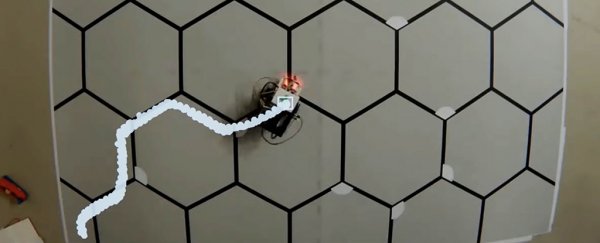Rather than engineering robotic solutions from scratch, some of our most impressive advances have come from copying what nature has already come up with.
New research shows how we can extend that approach to robot 'minds', in this case by getting a robot to learn the best route out of a maze all by itself – even down to keeping a sort-of memory of particular turns.
A team of engineers coded a Lego robot to find its way through a hexagonal labyrinth: by default it turned right at every function, until it hit a point it had previously visited or came to a dead end, at which point it had to start again.
Crucially, the software on board the robot was able to remember the false turns it had made on previous runs and make corrections the next time. This was achieved by tuning a neuromorphic circuit that helps determine which way the robot turns, in a similar way that synapses between neurons in the human brain strengthen their connections through repetitive use.
"Just as a synapse in a mouse brain is strengthened each time it takes the correct turn in a psychologist's maze, our device is tuned by applying a certain amount of electricity," says electrical engineer Imke Krauhausen, from the Eindhoven University of Technology in the Netherlands.
"By tuning the resistance in the device, you change the voltage that controls the motors. They in turn determine whether the robot turns right or left."
The robot took 16 attempts to find its way out of the maze, which measured two square meters (nearly 22 square feet).
Key to the correct operation of the robot was a particular polymer – p(g2T-TT) – used on the device's neuromorphic circuit. The material can retain stored states for an extended period of time, which means the robot can imprint its experience in the maze, picked up by a sensorimotor, to use as its 'memory'.
By building a neuromorphic circuit like this rather than software-based learning algorithms, the researchers were able to cut down on the power demands and the size of the finished robot – this approach again mimics the brain, which has incredible power efficiency.
"This sensorimotor integration, in which sense and movement reinforce one another, is also very much how nature operates, so this is what we tried to emulate in our robot," says Krauhausen.
This builds on previous research from some of the team into how electronic devices can be more biological in their design and operation, while also achieving a high level of reliability and efficiency. We're now seeing a growing number of developments in this particular field.
Next, the scientists want to develop the amount of processing that can be done on board devices themselves, which will require further engineering improvements and larger grids of circuits to take on more complex tasks.
Eventually, systems like this could be used in a wide variety of ways beyond helping robots to navigate. By cutting the reliance on software and the cloud, bots can operate independently and could even mesh with our bodies.
"Because of their organic nature, these smart devices can in principle be integrated with actual nerve cells," says Krauhausen. "Say you lost your arm during an injury. Then you could potentially use these devices to link your body to a bionic hand."
The research has been published in Science Advances.
